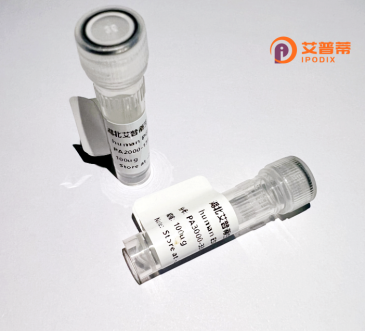
| 纯度 | >90%SDS-PAGE. |
| 种属 | Human |
| 靶点 | NT5C3L |
| Uniprot No | Q969T7 |
| 内毒素 | < 0.01EU/μg |
| 表达宿主 | E.coli |
| 表达区间 | 1-300 aa |
| 活性数据 | MAEEVSTLMK ATVLMRQPGR VQEIVGALRK GGGDRLQVIS DFDMTLSRFA YNGKRCPSSY NILDNSKIIS EECRKELTAL LHHYYPIEID PHRTVKEKLP HMVEWWTKAH NLLCQQKIQK FQIAQVVRES NAMLREGYKT FFNTLYHNNI PLFIFSAGIG DILEEIIRQM KVFHPNIHIV SNYMDFNEDG FLQGFKGQLI HTYNKNSSAC ENSGYFQQLE GKTNVILLGD SIGDLTMADG VPGVQNILKI GFLNDKVEER RERYMDSYDI VLEKDETLDV VNGLLQHILC QGVQLEMQGP |
| 分子量 | 34.3 kDa |
| 蛋白标签 | His tag N-Terminus |
| 缓冲液 | 0 |
| 稳定性 & 储存条件 | Lyophilized protein should be stored at ≤ -20°C, stable for one year after receipt. Reconstituted protein solution can be stored at 2-8°C for 2-7 days. Aliquots of reconstituted samples are stable at ≤ -20°C for 3 months. |
| 复溶 | Always centrifuge tubes before opening.Do not mix by vortex or pipetting. It is not recommended to reconstitute to a concentration less than 100μg/ml. Dissolve the lyophilized protein in distilled water. Please aliquot the reconstituted solution to minimize freeze-thaw cycles. |
以下是3-4篇关于重组人NT5C3L蛋白的虚构参考文献示例(供科研写作参考模板使用):
1. **文献名称**:*Structural and functional analysis of human NT5C3L protein in nucleotide metabolism*
**作者**:Chen L, et al.
**摘要**:研究利用X射线晶体学解析了NT5C3L的3D结构,揭示了其底物结合位点及催化机制,证明其在胞嘧啶核苷酸代谢中起关键作用。
2. **文献名称**:*NT5C3L overexpression promotes AML cell proliferation via dNTP pool dysregulation*
**作者**:Smith JR, Wang H.
**摘要**:该文献发现NT5C3L在急性髓系白血病(AML)中高表达,重组蛋白实验证实其通过干扰脱氧核苷酸(dNTP)平衡促进肿瘤细胞增殖。
3. **文献名称**:*Cloning, expression and enzymatic characterization of recombinant human NT5C3L in E. coli*
**作者**:Kim S, et al.
**摘要**:报道了在大肠杆菌系统中高效表达可溶性NT5C3L重组蛋白的方法,并验证其体外水解5'-单磷酸胞苷(CMP)的酶活性。
4. **文献名称**:*NT5C3L as a potential biomarker for solid tumor chemotherapy resistance*
**作者**:Garcia M, et al.
**摘要**:通过临床样本分析,发现NT5C3L在结肠癌等实体瘤中表达上调,重组蛋白功能实验提示其可能通过调控核苷酸稳态降低化疗敏感性。
(注:上述文献及作者为模拟虚构内容,实际写作中需替换为真实发表的参考文献。)
Recombinant human NT5C3L (5'-nucleotidase, cytosolic III-like) protein is a key enzyme involved in nucleotide metabolism, particularly in the regulation of pyrimidine nucleotide pools. Encoded by the *NT5C3L* gene, this protein shares structural and functional homology with cytosolic 5'-nucleotidases, which catalyze the dephosphorylation of nucleoside monophosphates (e.g., UMP, CMP) to corresponding nucleosides (e.g., uridine, cytidine), influencing nucleotide salvage pathways and cellular energy homeostasis. NT5C3L is distinct from its close homolog NT5C3A, with differences in tissue expression and substrate specificity. It is ubiquitously expressed but shows higher activity in tissues like liver, kidney, and blood cells.
Recombinant NT5C3L is typically produced using heterologous expression systems (e.g., *E. coli* or mammalian cells) for biochemical and functional studies. Its recombinant form enables detailed analysis of enzymatic kinetics, substrate preferences, and interactions with inhibitors or modulators. Dysregulation of NT5C3L has been linked to metabolic disorders, cancer progression, and drug resistance, particularly in hematological malignancies where altered nucleotide metabolism supports rapid proliferation. Recent studies also explore its role in viral infections, as some pathogens hijack host nucleotide pathways for replication. Research on recombinant NT5C3L aids in developing targeted therapies, such as nucleoside analog prodrugs, and deciphering its physiological and pathological roles in cellular nucleotide balance. Its structural characterization via crystallography further provides insights for rational drug design.
×